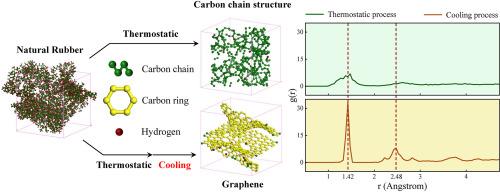The graphene formation via flash Joule heating: The effect of cooling rate
IF 9.4
1区 工程技术
Q1 ENERGY & FUELS
引用次数: 0
Abstract
Conventional graphene synthesis encounter significant challenges in scalability, cost, and efficiency, which hinder their industrial applicability. Although flash Joule heating (FJH) enables the efficient and cost-effective production of high-quality graphene, its underlying mechanism, particularly the effect of cooling rate, has not been thoroughly investigated. In this work, ReaxFF molecular dynamics (ReaxFF MD) simulations were utilized to investigate the conversion of natural rubber into graphene via FJH. The results demonstrated that the rapid cooling process played a critical role in flash graphene formation. Radial distribution function analysis confirmed that the products obtained under cooling were high-quality graphene, with further improvements observed at slower cooling rates (0.22 K/ps and 0.44 K/ps). Moreover, potential energy assessments indicated that cyclization occurred more rapidly under ultrafast cooling, resulting in lower-quality graphene. Two crucial mechanisms were revealed to govern graphene formation via FJH. Firstly, the carbon source underwent rapid pyrolysis at transient high temperatures, during which tar and gases were released, leaving behind a char residue that condensed into graphene during the subsequent rapid cooling stage. Secondly, the reduction in system potential energy during the cooling process facilitated cyclization, with the reaction initiating once the potential energy reached approximately 75000 kcal/mol.

闪蒸焦耳加热石墨烯的形成:冷却速率的影响
传统的石墨烯合成在可扩展性、成本和效率方面面临重大挑战,阻碍了其工业应用。虽然闪蒸焦耳加热(FJH)能够高效且经济地生产高质量的石墨烯,但其潜在的机制,特别是冷却速率的影响,尚未得到彻底的研究。在这项工作中,利用ReaxFF分子动力学(ReaxFF MD)模拟来研究天然橡胶通过FJH转化为石墨烯。结果表明,快速冷却过程在闪蒸石墨烯形成过程中起着关键作用。径向分布函数分析证实,在冷却下得到的产品是高质量的石墨烯,在较慢的冷却速率(0.22 K/ps和0.44 K/ps)下观察到进一步的改善。此外,势能评估表明,在超快冷却下,环化发生得更快,导致石墨烯质量下降。通过FJH,揭示了控制石墨烯形成的两个关键机制。首先,碳源在瞬态高温下快速热解,在此过程中释放焦油和气体,留下焦渣,在随后的快速冷却阶段凝结成石墨烯。其次,冷却过程中系统势能的降低有利于环化,当势能达到约75000 kcal/mol时反应开始。
本文章由计算机程序翻译,如有差异,请以英文原文为准。
求助全文
约1分钟内获得全文
求助全文
来源期刊

Energy
工程技术-能源与燃料
CiteScore
15.30
自引率
14.40%
发文量
0
审稿时长
14.2 weeks
期刊介绍:
Energy is a multidisciplinary, international journal that publishes research and analysis in the field of energy engineering. Our aim is to become a leading peer-reviewed platform and a trusted source of information for energy-related topics.
The journal covers a range of areas including mechanical engineering, thermal sciences, and energy analysis. We are particularly interested in research on energy modelling, prediction, integrated energy systems, planning, and management.
Additionally, we welcome papers on energy conservation, efficiency, biomass and bioenergy, renewable energy, electricity supply and demand, energy storage, buildings, and economic and policy issues. These topics should align with our broader multidisciplinary focus.
 求助内容:
求助内容: 应助结果提醒方式:
应助结果提醒方式:


